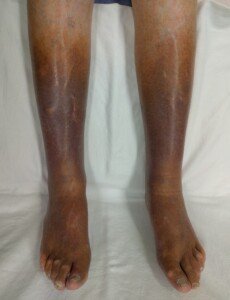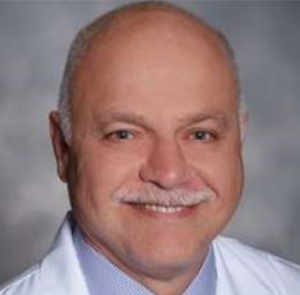
Venous insufficiency can lead to noticeable varicose veins and sometimes only discoloration and swelling.
Being overweight and under-exercised, according to my lifelong observation of the red/purple and swollen legs of venous insufficiency, seem to be the two conditions strongly linked to these visible characteristics.
Ironically, whenever I see someone with thick varicose veins rippling up and down their legs, that person is never obese and is usually on the trimmer side.
So based on my observations over many years, I asked a vascular surgeon if indeed, only weight loss and a good leg exercise program (squat, leg press, walking lunge) could reduce the visible signs of venous insufficiency.
Now remember, this is about improving an existing problem rather than taking measures (weight control and intense exercise) to actually prevent it from ever developing in the first place.
“Venous insufficiency is a condition related to incompetent vein valves,” says Seyed-Mojtaba Gashti, MD, a board certified vascular surgeon with Broward Health Medical Center in Florida.
“Veins, unlike arteries, carry blood back to the heart, and the veins in our legs have valves to allow blood flow only in one direction: towards the heart.
“If these valves are not functioning well, then the blood would flow down to the legs and over time you developed the varicose veins, swelling, etc.”
This is called venous insufficiency.
“There is no cure for this condition,” continues Dr. Gashti.
“So weight loss and/or exercise will not cure this condition, but they can help reduce the signs and symptoms of it.
“As we walk or use our leg muscles in other ways, the contraction and expansion of the muscles provide a pumping action that helps move blood through these valves.
“Obesity is a known risk factor for cardiovascular disease, and weight loss can be beneficial in that regard; but it also reduces the stress on the veins and may improve the symptoms.”
When I was a personal trainer I never had a client with visible venous insufficiency in the form of swollen reddish or purple legs.
But I did have a client who had painful peripheral vascular disease. Her legs looked normal, but walking was painful, primarily because pressure on her feet from any walking caused pain.
She used a wheelchair in public but was able to walk around the gym.
She was an overweight smoker. Despite these odds stacked against her, she was able to perform leg presses on a machine with an impressive amount of weight – as much as any other typical woman using the same equipment – even more than many, since I’d always encourage my clients to press as much weight as possible (with good form and proper breathing).
I also had her doing high intensity interval training (aka “sprint training”) on a stationary bike.
She was as good as the next woman. I certainly kept her away from the treadmill and walking lunges.
As a fitness enthusiast, I’d like to see more people who have swollen, red or purple legs from venous insufficiency working out in a gym.
With their doctor’s endorsement, they can experiment with various leg exercises and see which ones are tolerable as far as pain.
However, venous insufficiency is not a contraindication to upper body exercise while seated or lying down, such as machine and dumbbell workouts and the bench press!
Though swollen, red and purple legs are unsightly and can be a source of self-consciousness to some people, they may want to wear long sweats or leggings to feel more at ease at a gym. Leggings are extremely common among all women.
But I’d like them to know that many people at gyms have less-than-attractive legs (obesity, cellulite, “chicken” legs, varicose veins) and exercise in shorts nevertheless. And nobody cares!
Even just only upper body workouts (plus dietary control) will help the overweight person with venous insufficiency lose weight, which, as Dr. Gashti points out, can help with this medical condition.

Dr. Gashti specializes in the diagnosis and treatment of vascular disease including abdominal and aortic aneurysm.
 Lorra Garrick has been covering medical, fitness and cybersecurity topics for many years, having written thousands of articles for print magazines and websites, including as a ghostwriter. She’s also a former ACE-certified personal trainer.
Lorra Garrick has been covering medical, fitness and cybersecurity topics for many years, having written thousands of articles for print magazines and websites, including as a ghostwriter. She’s also a former ACE-certified personal trainer.
.


























